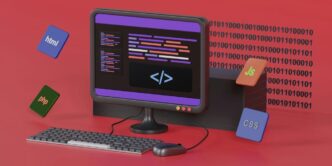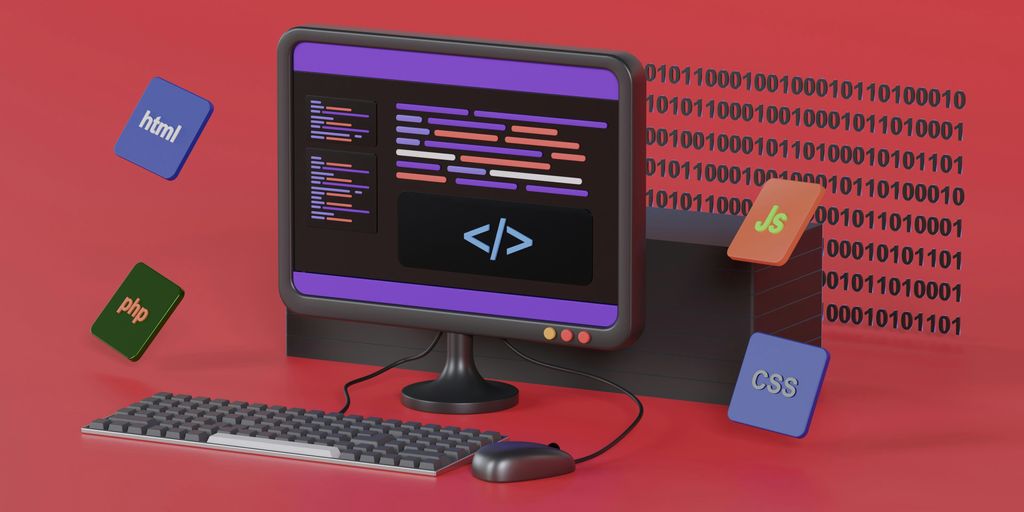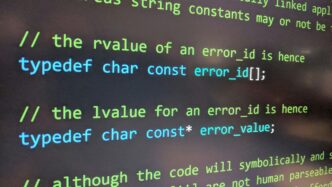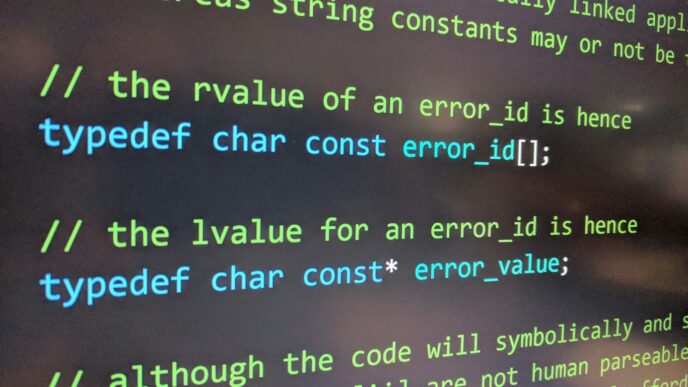So, you’re wondering what the deal is with programming languages for artificial intelligence, especially as we head into 2025? It’s a pretty big topic, and honestly, the landscape keeps changing. Picking the right language can make a huge difference in how smoothly your AI project goes, how fast it runs, and even what you can actually build. This article is going to break down some of the top contenders. We’ll look at what each one is good for, and why it might be the perfect fit for your next big AI idea. Let’s get into it.
Key Takeaways
- Python is super popular for AI because it’s easy to use and has tons of ready-made tools.
- R is a good choice if you’re really into statistics and making nice data pictures.
- Julia is fast for scientific work, kind of like a speedy version of Python or R for certain tasks.
- Java is often used for big company AI systems that need to work across different computers.
- JavaScript lets you put AI right into web pages and mobile apps, which is pretty neat.
1. Python
If you’ve even taken a quick look at AI, you’ve probably noticed Python is everywhere. It’s super popular because it’s versatile, has tons of libraries, and is easy to read. It’s used for everything from quick experiments to complex AI systems ready for real-world use.
Python is a favorite among AI engineers because it’s easy to understand and can be used in many ways. It’s simpler than languages like C++ and Java and can handle different programming styles. Plus, it works on different operating systems like Linux, Windows, and macOS. It’s great for AI because it has lots of helpful tools and libraries like Keras, MXNet, TensorFlow, PyTorch, NumPy, and Scikit-Learn. If you’re reading cutting-edge deep learning research, you’ll find that most studies that offer source code do so in Python.
Here’s why Python is a top choice for AI:
- Tons of Libraries: Python has amazing AI and machine learning libraries like TensorFlow, PyTorch, and Scikit-learn. These make it easier to do things like create neural networks and work with natural language.
- Big Community: Python has one of the biggest programming communities out there. If you need help, there are lots of tutorials and support available.
- Easy to Read: Python’s design makes it easy to read, write, and fix code. You don’t have to struggle with complicated code filled with brackets.
- Works Everywhere: You can write code once and run it on Windows, macOS, or Linux.
- Quick Prototyping: Python lets you try out AI ideas quickly, which is great for coming up with new things fast.
But, there are some things to keep in mind:
- Can Be Slow: Python can be slower than languages like C++ or Java, especially when doing a lot of number crunching.
- Global Interpreter Lock (GIL): This can limit how well Python uses multiple computer processors, which can slow down tasks that use multiple threads.
- Needs Resources: Python might not be the best choice for devices with limited memory.
- Limited Mobile Support: It’s not the best for AI-powered mobile apps.
- Not Much Low-Level Control: If you need to really optimize how the system works, you might need to use lower-level languages.
2. R
R is a big deal in the data science world, and it’s easy to see why. It’s got some serious skills when it comes to stats and making cool visuals. If you’re into digging deep into data and showing off what you’ve found, R might be your jam. It’s like having a super-powered calculator that also makes pretty charts. I remember when I first tried using R; the syntax felt a bit weird, but once I got the hang of it, I was hooked. It’s not always the fastest, but it gets the job done, especially when you need to analyze patterns in data.
The Good Stuff About R for AI
- Data Analysis Powerhouse: Packages like
Dplyrandtidyversemake messing around with data way easier. Seriously, it’s like they thought of everything. I usedDplyrlast week to clean up a messy dataset, and it saved me hours. - Visualization Magic: With
ggplotandggplot2, you can make some seriously good-looking charts. These are super important when you’re trying to explain AI models to people who aren’t super techy. - Statistical Muscle: R’s got all sorts of fancy stats functions that let you really dig into your data and see how well your AI model is doing. It’s like having a stats expert built right into the language.
- Community Vibes: There’s a huge group of statisticians and scientists who use R, so if you get stuck, there’s always someone around to help. Plus, everyone shares their code and resources, which is awesome.
- Plays Well with Others: R can work with AI frameworks like
TensorFlow,Keras, andH2O.ai. It’s nice when things just work together, you know?
The Not-So-Good Stuff About R for AI
- Speed Isn’t Its Thing: If you’re dealing with a ton of data, R can be a bit slow compared to Python or some other languages. It’s not a deal-breaker, but something to keep in mind.
- Niche Focus: R is great for data science, but it’s not as good for other AI stuff. It’s like using a screwdriver when you need a wrench.
- Deployment Headaches: Getting AI models written in R up and running in the real world can be tricky. It’s not always straightforward.
- Not a Jack-of-All-Trades: If you’re not doing data analysis, R might not be the best choice. There are other languages that are more versatile.
- Learning Curve Alert: R’s syntax can be a bit confusing if you’re new to programming. It takes a bit of getting used to, but it’s worth it in the end.
3. Julia
Julia is the new kid on the block, but it’s quickly making a name for itself in AI, especially where speed is key. It was designed to be fast, like C++, but also user-friendly, like Python. Think of it as the best of both worlds. Julia excels at numerical and data-heavy tasks, making it a rising star for performance-critical AI applications.
Why is Julia gaining traction? Well, it’s got a few things going for it:
- Speed: Julia is seriously fast. We’re talking about speeds that can rival C++ in some cases. This is a huge deal when you’re training massive AI models that require tons of calculations. Imagine AI transforming financial services with Julia’s speed.
- Scientific Computing Focus: Julia was built with scientific computing in mind. It’s got features that make it perfect for things like numerical analysis and data manipulation. If you’re working with complex algorithms, Julia is a solid choice.
- Growing Ecosystem: While it’s not as mature as Python’s, Julia’s library ecosystem is growing fast. Libraries like Flux.jl and MLJ are providing more and more tools for machine learning.
Of course, Julia isn’t perfect. It’s still a relatively young language, so its ecosystem isn’t as vast as some of the more established players. This can be a hurdle if you’re relying on pre-built solutions. Also, while the syntax is approachable, some users might still face adoption hurdles. But, the potential is there, and it’s exciting to see where Julia goes in the future.
4. Java

Java remains a solid choice for AI in 2025, especially for projects needing to integrate with existing enterprise systems. It’s not always the flashiest language, but it’s reliable and scalable. Think of it as the workhorse of the AI world. Java’s cross-platform compatibility guarantees applications can easily scale across various environments.
Java brings some key strengths to the table:
- Scalability: Java handles complex AI projects with tons of data and calculations. It can expand and change to adapt according to your AI project needs.
- Enterprise-Ready: Many large companies and organizations already use Java, so it’s a familiar choice for building enterprise-grade AI systems. Java has already been adopted by many influential builders, making collaborating and sharing resources easier.
- Mature Ecosystem: Java has been around for a while, meaning there’s a wealth of libraries and tools available. This can save you time and effort when developing AI applications.
However, Java isn’t without its drawbacks:
- Performance: While Java is generally fast, it might not match the raw speed of languages like C++ for certain computationally intensive AI tasks.
- Verbosity: Java code can sometimes be a bit wordy, which can slow down rapid prototyping and experimentation.
- Memory Usage: Java applications can sometimes require more memory than those written in other languages.
5. JavaScript

JavaScript? For AI? Yeah, I know, it might sound a little weird at first. We all think of it as the language that makes websites do cool stuff, but it’s actually becoming a bigger player in the AI world, especially for stuff that runs right in your browser. Think about it: everyone uses the web. Why not put the AI there too?
JavaScript’s Upsides for AI
- It works everywhere: JavaScript runs on the front-end (what you see in your browser) and the back-end (with Node.js). This makes it perfect for web based AI that’s easy to get to.
- The toolbox is growing: Libraries like TensorFlow.js and Brain.js are bringing machine learning right to JavaScript. It’s getting easier to build AI into your websites.
- It’s quick on its feet: JavaScript handles real-time data well, which is important for interactive AI applications. Think live translations or real-time image filters.
- Lots of people know it: JavaScript has a huge community, so there’s always someone around to help if you get stuck. Plus, it’s relatively easy to learn.
- Cross-Platform Reach: You can build apps for desktops, the web, and phones using the same code.
JavaScript’s Downsides for AI
- It can get slow: JavaScript can struggle with really big, complicated AI models. It’s not always the fastest language out there.
- Fewer specialized tools: While it’s getting better, JavaScript still doesn’t have as many AI-specific libraries as Python.
- Better for simpler stuff: Because of its limitations, JavaScript is often better for simpler AI tasks. Don’t expect to build the next self-driving car with it (yet).
- Memory can be a pain: JavaScript manages memory automatically, which can sometimes cause delays, especially in real-time applications.
- Debugging can be tricky: When things go wrong in a big, browser-based AI project, finding the problem can be a real headache.
Basically, JavaScript is great for bringing AI to the web, but it’s not always the best choice for super complex or performance-intensive tasks. It’s like using a Swiss Army knife – it’s versatile, but not always the best tool for every job. It’s becoming a key player in web-based AI.
6. C++
C++ remains a powerhouse in the AI world, especially when performance is key. I mean, we’re talking about a language that’s been around the block and still manages to keep up with the young guns. Its speed and efficiency make it a go-to for computationally intensive tasks.
Think about it: AI is all about processing massive amounts of data quickly. C++ lets you get down to the metal, directly manipulating hardware resources for optimized performance. This is super important for machine learning and deep learning applications where every millisecond counts. Plus, its interoperability with Java means you can tap into a huge ecosystem of existing libraries. It’s like having the best of both worlds.
Here’s a quick look at why C++ is still relevant:
- Speed: C++ is blazingly fast, crucial for complex AI models.
- Hardware Control: It offers direct access to hardware, optimizing performance.
- Mature Ecosystem: A long history means plenty of libraries and tools are available.
Of course, C++ isn’t without its challenges. It has a steeper learning curve than some other languages, and you need to be comfortable with memory management. But if you’re serious about AI and need raw power, C++ is definitely worth considering. It’s a workhorse that continues to deliver, especially when you need to deploy an AI model into a low-latency production environment.
7. Lisp
Lisp, one of the oldest programming languages, has a long and interesting history with AI. Developed way back in the late 1950s, it was designed with symbolic processing in mind. This makes it a natural fit for AI research, which often involves manipulating symbols and processing lists. Its historical significance isn’t just about nostalgia; Lisp has evolved alongside AI, influencing and being influenced by it.
Lisp has some cool features that make it good for AI:
- Flexibility and Dynamism: Lisp is super flexible, which means you can quickly prototype and develop things. Features like dynamic typing, conditionals, and recursion are perfect for AI tasks. Lisp programs can even modify themselves while running, which is awesome for AI applications that learn and adapt. This is important for the future evolution of AI.
- Macros and Code-as-Data: Lisp’s macro system lets developers extend the language to fit their specific needs. The code-as-data thing (homoiconicity) makes it easy to generate and mess with code. This is great for writing complex AI algorithms that can use metaprogramming.
- Garbage Collection: Lisp automatically manages memory, so developers can focus on the AI logic without worrying about memory leaks and stuff. This is a big time-saver.
However, Lisp can be tough to learn if you’re not used to its unique syntax and programming style. Plus, it’s not as popular as some newer languages like Python. Still, it’s a favorite in parts of the AI community because it’s simple and has a good ecosystem of AI libraries.
8. Haskell
Haskell, known for its functional programming style, brings something unique to the AI table. It’s all about pure functions, where the output depends only on the input, making code easier to test and understand. This is super helpful in AI, where algorithms need to be reliable.
Think of it like this:
- Concise Code: Haskell often lets you write shorter, more readable code. It’s like saying a lot with a little.
- Modular Design: Breaking code into independent parts makes it easier to manage, especially for complex AI systems. You can build your AI program with blocks, each with a clear job and easy to swap out.
- Less Prone to Errors: Haskell’s way of handling data can make your AI code more reliable. It cuts down on unexpected crashes.
However, Haskell’s different approach can be tricky. Its syntax can be unlike other languages, which means a learning curve. It’s like learning a new way to think about code. But, the benefits in terms of code clarity and reliability can be worth it, especially when dealing with complex AI models. Plus, Haskell’s laziness can help simplify code and boost efficiency. Haskell is a robust, statically typed programming language that supports embedded domain-specific languages necessary for AI research. The AI in Education Market is growing, and Haskell could play a role.
9. MATLAB
MATLAB, short for Matrix Laboratory, is a numerical computing environment and programming language. It’s been a staple in engineering and scientific fields for ages, and it still holds relevance in AI, particularly for tasks involving numerical simulations and algorithm development. MATLAB excels at matrix manipulations, data analysis, and creating visualizations, making it useful for prototyping AI models and analyzing their performance.
MATLAB isn’t always the first language people think of for cutting-edge AI research, but it has a solid foundation and a dedicated user base, especially in industries like aerospace and control systems, where robust simulations are key. It’s like that reliable old tool in your garage – maybe not the flashiest, but it gets the job done.
MATLAB is also used in AI in drug discovery because of its numerical capabilities.
10. Prolog
Prolog, short for "Programming in Logic," is a language that really shines when it comes to AI, especially for stuff that needs some serious logical reasoning. Think natural language processing and representing knowledge – that’s where Prolog excels. Its declarative nature is a big plus; instead of telling the computer how to solve something, you describe what the problem is.
It’s got some cool features:
- Declarative Style: You focus on describing the problem’s logic, not the step-by-step solution.
- Backtracking: Prolog can automatically explore different paths to find solutions, which is super useful for things like game AI.
- Pattern Matching: It’s great at parsing and working with symbolic data, making it perfect for understanding language.
Sure, Prolog’s syntax can be a bit of a learning curve if you’re used to other languages. And for AI tasks that need a lot of number crunching, other languages might be a better fit. But for logic-heavy AI, Prolog is still a strong contender.
Wrapping Things Up
So, we’ve looked at a bunch of programming languages that are big in the AI world for 2025. There’s Python, which everyone seems to love because it’s easy to use and has tons of tools. Then you’ve got R, which is great if you’re really into numbers and making pretty charts. Julia is super fast for certain jobs, and Java is still around, doing its thing for bigger company systems. And don’t forget JavaScript, bringing AI right to your web browser. The main takeaway here is that there isn’t one ‘best’ language for everything. It really just depends on what you’re trying to build, what you already know, and where you want your project to end up. Pick the one that feels right for your next big idea.
Frequently Asked Questions About Top Languages for AI in 2025
What is the best programming language for AI development in 2025?
Python is generally seen as the top choice for AI in 2025. It’s super popular because it has lots of ready-to-use tools (like TensorFlow and PyTorch), it’s easy to read, and there’s a huge community of people who use it and can help you out. But the best language really depends on what your specific AI project needs.
When should I use R instead of Python for AI?
You should pick R when your project is all about deep statistics or making really cool data pictures. R is like a superhero for number crunching and showing off data in neat ways. If you’re doing lots of research with numbers, R is a fantastic pick.
Is Python the only language used for AI development?
No, not at all! While Python is super popular, languages like Java, C++, R, and Haskell are also really important for building strong AI programs. The best language truly depends on the exact needs of your AI project.
How do I choose the right programming language for my AI project?
When picking an AI language, think about a few things: Is it popular? (More users mean more help!) Is it easy to learn? Does it have lots of tools and libraries? And how fast can it make your AI run? Some languages are like race cars for specific tasks!
Will learning an AI programming language help me get a job?
Yes, learning an AI programming language can definitely help you get a good job. Companies are always looking for people who know how to build AI. Knowing these languages opens up many chances for you to grow in your career.
Which AI programming language is easiest for beginners?
For beginners, Python is often the easiest to start with because it reads a lot like plain English and has a ton of learning materials and a supportive community. It helps you get started with AI without too much fuss.














